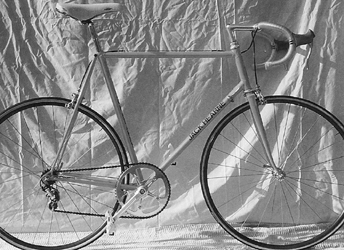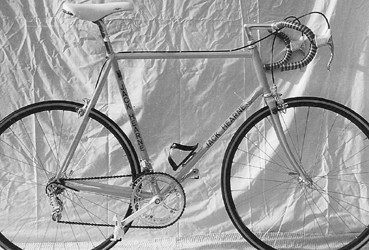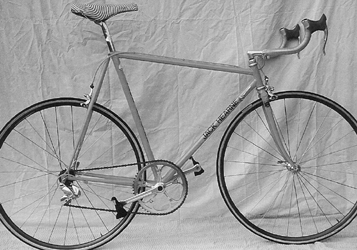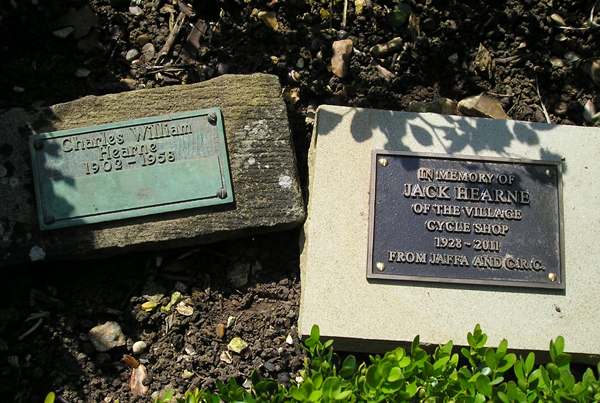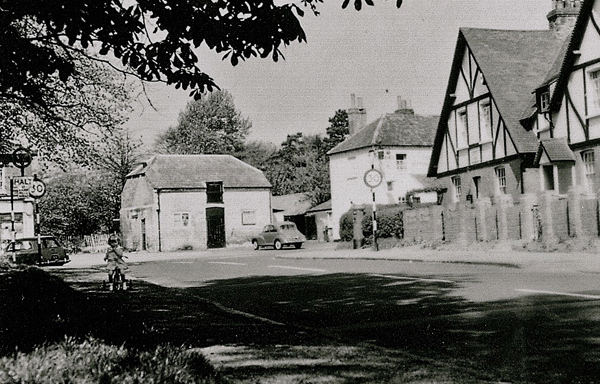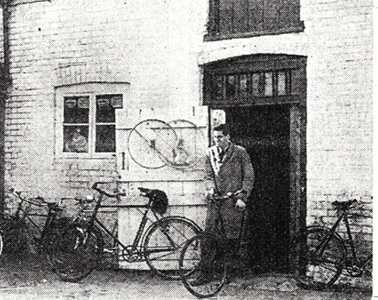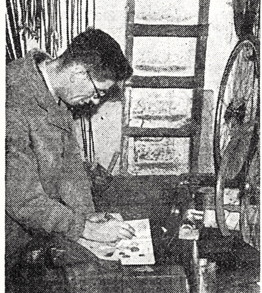Hearne, Jack
Posted: Tuesday 02nd June 2020
Jack Hearne spent his childhood in the small village of Stoke Poges just three miles north of Slough in Buckinghamshire. After World War II he had a newspaper delivery job with which came his own transport – a bike.
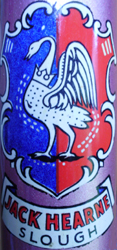
After Army National Service Jack started work in his uncle’s village garage at Stoke Poges driving a taxi. There he was also introduced to cycle repairs, as most garages after World War II also sold bicycles. Jack then attended evening classes at the London Polytechnic to learn the craft of cycle frame-building. His first shop, again in Stoke Poges, was in a converted barn next door to one of the village’s public houses. Jack started frame building indoors in the loft area above the shop. A flat table-top board with frame angles and sizes etc was used to prepare and cut the tubes to length, and to file lugs and tube ends prior to setting to the angles required. The board was also used to pin the tubes before brazing took place; jigs were not often used by the smaller frame builders at this time.
The “forge” for brazing the frame tubes was outside the shop in a canvas-covered metal framed extension. This also housed an electric oven for stove-enamelling, the painting of finished frames. Later, a larger oven, fuelled by bottled gas, was installed. This was large enough for tandem frames or several normal size frames. Jack also became involved in paint spraying and re-enamelling customers frames, often learning by trial and error the best way to achieve a good finish.
Old paint was removed from frames by burning off. A large flame was played over the frame then was rubbed quickly with a wire brush. After that there was a lengthy session with an emery cloth to polish the tubes to a shiny finish. Many years later old paint was removed by shot-blasting and the frame was held in a cabinet. This was time-consuming so Jack then built a complete room for shot-blasting. He had to wear a helmet complete with an air supply, similar to that of a deep sea diver, due to the dusty atmosphere in the room. Jack always did his own paint spraying, transfers and lacquering. Transfer quality was not so good in the early days and often a frame had to be re-sprayed to achieve the best finish.
One of the London frame builders, Les “The Filer” Sylvester, often came to Stoke Poges for a day’s work with Jack, as did Len Hart who worked with Gillott before joining the management at Dawes Cycles.
I started work in Jack’s shop at the age of 11 years old. The first skill I acquired was mending punctures, allowed only to use tyre leavers to remove the tyre and
fingers to refit it! After a while I was shown how to polish the tubes of the newly built frame with a piece of emery cloth. Jack insisted that the grain of the polish had to run in the same direction which obviously helped to get a superb finish.
During the 1950’s and 60’s cycle road racing was on the up and so Jack became involved in that and also encouraged people to try it. To help financially, he ran a “club” savings account for the racers to pay in what they could afford, so that they could have a new bike straight away. Jack’s local club was The Chiltern Road Club, based at High Wycombe. He was President and Race Organiser for many years, holding races for amateurs and semi-pro’s independents.
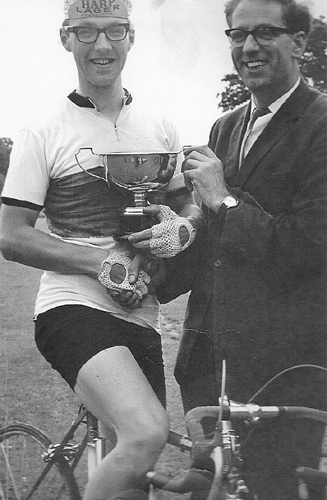
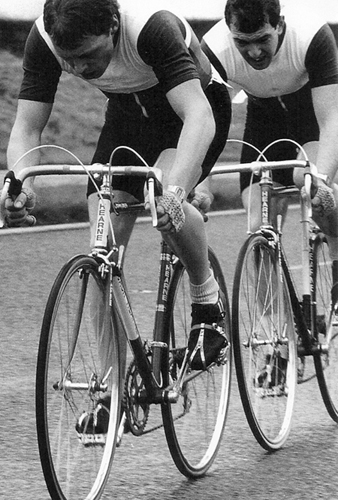
Jack later had a custom-built shop three miles to the south of the village in Slough. This shop had a large showroom for around 120 cycles, a workshop in the basement, and further work areas at the rear. He built his own shot-blasting room for the removal of old paint, and installed a larger paint spray unit with air extractors. The unit enabled him to give the frames a finish second to none.
During the 1960s many smaller frame building shops sponsored riders for road racing. Larger shops may have had three or four riders, with team names such as “Wally Green Cycles”, “Condor-Mackeson”, “Quinn-Everyman”, ” Ryall-Raxar” and “Witcombes”. These teams could be seen racing along with the bigger teams of “Viking Cycles”, ” Falcon Cycles”, ” Dawes”, “Raleigh”, and others.
Jack was a race mechanic with the England Team on several occasions in the Tour of Britain. The team leader was Bill Bradley, a winner. Jack was awarded one of the yellow jerseys for his work on the team. He also went with a team to the Tour of Sweden and the European Tour of Youth.
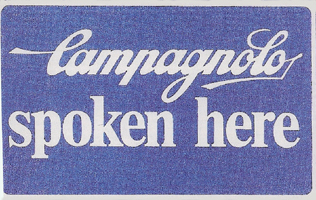
Jack’s village, Stoke Poges, produced a future champion cyclist, Eddie Adkins, son of the village policeman. Eddie went on to win the National 25-Mile Championships in 1977, 1978 and 1979. Eddie rode a Jack Hearne frame for many years of his racing career and Jack was very proud of Eddie’s numerous race wins.
I offer my sincerest thanks to Jack for teaching me so much over the past 45 years, not least for giving me my nick-name ” Jaffa ”
Geoff (Jaffa) Orange
Former Secretary of Chiltern Road Club.
June 2011
I was especially interested in the Jack Hearne and Dave Russell pages, my cycling career started at the age of 13 or 14 when I joined the Chiltern Road Club and Jack and Jaffa introduced me to the Tuesday chain gang. Jack drove a battered old white Ford Cortina with all the windows down shouting instructions and Jaffa motor-paced us almost back to the end of the line on his moped – he always left a couple of bike lengths for us to close on our own. No sooner were we back on than Jack was shouting at us for missing our turns, I think it is fair to say it was more often me than us at first.
I also used the blue tick book (credit) quite extensively! However, I was not a star in the making, there was no money and very little support at home and I made do with a pretty rubbish bike dreaming of the day I could get on one of the FH Grubbs or Jacks own frames that filled the shop.
I remember that Jack knew how much everyone owed and what kit there was on everyone’s bike and woe betide anyone who bought kit elsewhere – especially if it was from Dave Russell! The shop was always immaculate and ably staffed by a lady named Joyce who must have had the patience of a saint. Although I got on alright with Jack it was never really as a friend and the shop was run exactly in the same manner.
Later on, I think in 1969 or 1970 I started doing a lot with the Windsor Section of the South Bucks CTC where I met Alan and did a bit of time-trialling in the racing part of the Section – the South Bucks Road Club. Just about everyone went to Dave’s and I did too, firstly to his tiny shop in the indoor Market in Slough and then in Chalvey (from 1969 to about 1988-ish) and latterly to Twyford (this was Peter Hare’s old shop).
Dave also had a workshop cum shop down the bottom of his garden. I was an army chef and often in Germany but when I was home I spent a lot of my leave and days off in the shop especially in Chalvey, building bikes, doing repairs, serving behind the counter, as well as making the lunch and coffees for people who “popped in for something quickly and were still there 5-hours later. We used to call it the only bike shop in the country with full-time professional catering staff.
I helped Dave with the move out of Chalvey to the shed and can remember a couple of occasions when I drove him up to Joe Whiskers at Welwyn to buy kit, it has to be said some of it was for me so a vested interest at times but it gave him a chance to relax a bit.
Lots of other people did much as I did over the years, if you were in the shop and something needed to be done we helped out. Unlike Jack’s all the shops were untidy but the products, frames, wheels and bikes were fantastic. There was a clubroom atmosphere to the shops too that meant people stayed.
In all I have had five bikes with the Russell badges, the first was an off-the-peg fast-back time-trial framed road bike which I sold in a moment of madness. One was built in 1975 by a lad called Phil who worked there at the time, two were built by Dave himself and lastly I have a mountain bike badged Dave Russell but built by Nigel Dean – the ex pro rider. Dave did the framebuilding consultancy work for him and that was part of the deal. The head badge on that though was a diamond design and was used for frames Dave did not build himself. The photos of the head badges are interesting – all of my bikes have the Swan but not Slough underneath,
I can remember roughly when Dave started to use those in around 1970. Previously the transfers and head badges had been in what is described on the H LLoyd site as “Chinese lettering” and were waterslides very fragile and I guess expensive. Whether or not the Slough was removed because of the move away from Slough or for cost reasons I do not know.
I’m fairly certain that all the bikes were re enamelled in the 90’s in the shed at Dave’s house at 553 Bath Road (appropriate for a cyclist) Cippenham, Slough
I kind of lost touch with both cycling and Dave for a while in the late nineties which was a real shame, Dave was a good mate and I guess an inspiration to many people for so many years. I’m sure I would not be alone in saying that and it was not just in cycling – he was a swimming coach too.
Sadly Dave is no longer with us.
My 1975 frame is off to Mercian’s for a well-earned fresh paint job now that I have found out where to get the transfers – it just would not feel the same with a different name on. I think I have a photo of it though as original ,with TA chainset, Campag seatpin and hubs, Mafac Race cantilever brakes, Shimano bar end levers and sprints and tubs!
I’ll have to dig it out and send it to you for the site. I’ll do the same for the other bikes too though it has to said they are not quite so classically equipped but are fine frames nevertheless.
By the way in Ron’s narrative from Steve Heffernan there is a reference to Ian Bradbury – it was actually Ian Banbury
I’ve got a suitcase full of old Cycling Weekly’s with photos of them and Eddie Adkins etc. plus International Cycle Sports and if memory is right a couple of Ron Kitchings Everything Cycling
Edited from The Bicycle, 25 October 1950
As a schoolboy, Jack Hearne was undecided what he wanted to do when he left school, in 1942 although he started off by working in his uncle’s garage until he was called up to join the army. On demobilisation from the R.A.O.C. in 1946 Jack was emplyed by the new owners of the garage but he did not stay long.and decided to set up a cycle business.
Finding premises was almost impossible but in 1949 a friend stepped in and offered him part-use of a barn in Stoke Poges. His working space for the first few months was limited as the barn was used for coal storage in one corner, mangers in another and the landlords stores in a third one. Eventually he was granted use of the whole barn which entailed moving some six tons of coal, clearing the floor and whitewashing the walls white to brighten up the place. Next he fitted shelves and built a bench but problems arose when he was unable to get recognition from the National Association of Cycle Manufacturers. Without this memebers of the cycle trade would not do business with him, to add to his problems the landlord wouldn’t allow him to advertise his business in any way. Eventually he was awarded certification by the Association and salesman from firms in the trade began to call upon him.
To increase his knowledge of the trade he attended The Institute of Cycle Traders and Repairers evening classes and passed their examination.
I was delighted to read the article by Geoff Orange about Jack Hearne.
I was an 11-year old cycling fan who in 1961 dreamt of one day moving to France or Belgium to become a professional cyclist .
Living in Langley, Jacks shop in Slough near the Railway station was my local serious bike shop and had the benefit of being on my daily ride to school .
As the youngest member of Maidenhead cycling club in 1961 I was a frequent fixture in his shop and he very kindly allowed me to pay for items using the famous Club card as my pocket money permitted.
Using my nickname ‘Bun’ one day he said that I might as well work in the shop, which I happily did for several years at weekends and during school holidays, cleaning bikes and brewing the copious amounts of tea that were consumed each day in the shop.
In the 60s his frame building skills were amongst the best and as well as being a continual source of encouragement he built me a frame to suit my modest size .
Finished in bright orange with black Hearne transfers it was a de-rigueur frame of the time in double-butted Reynolds 531 with Campag fork ends and slightly sloping fork crown plus some nice lugwork. Over time I was able to top the bike off with Campag Record, Mavic rims and Mafac centre pull brakes plus the obligatory Brooks professional saddle …well softened and shaped !!
My family moved away to the West country in the mid 60s and although I kept in contact with Jack for several years afterwards eventually we lost contact.
My love of bikes and cycling fostered by Jack has continued to this day and I am sure he would have a wry smile and no doubt one of his appropriate expletives that at the age of 52 I rode my first of 3 Etape du Tours plus all the major Italian Grand Cycle Sportifs and yes I finally did make the move to France at the age of 63 where I ride my bike with friends from the local club several days each week.
Jack was a great frame builder, bike mechanic and friend .
Posted: Tuesday 02nd June 2020
This article appears in the following categories.
Upcoming Events
Whether you are looking for a gentle social meet up, or a 100-mile ride browse the community’s upcoming events and plan your next weekend outing.

